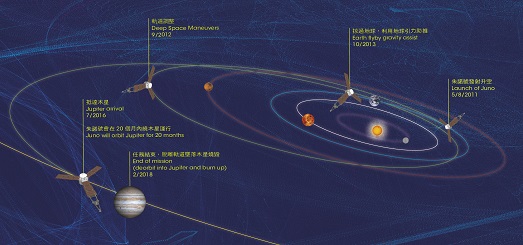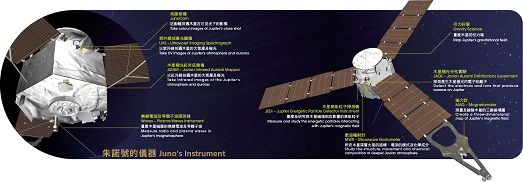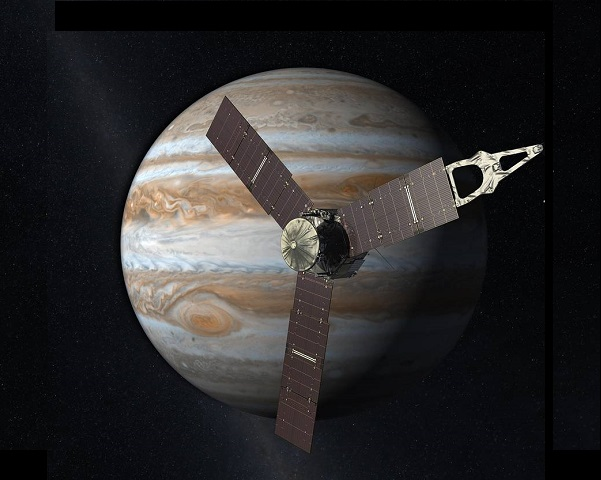
Juno, the spacecraft named after the Roman goddess who can peer through the clouds drawn by her husband Jupiter to hide his mischief, was launched on 5 August 2011 by NASA. After a five-year journey, Juno arrived at Jupiter in 2016. It has brought us clues about the giant planet's origin and evolution. This information is crucial to our understanding of the formation of the Solar System.
NASA's New Frontiers Program is a series of exploration missions to planets accorded with top priorities. Juno is the second mission under this program after New Horizons. It has conducted in-depth study of the most massive planet in the Solar System – Jupiter.
Juno was launched aboard an Atlas V 551 launch vehicle. The spacecraft measures only 3.5 metres high and 3.5 metres in diameter. Despite its small size, Juno carries 3 extraordinary large solar arrays, each of which can be extended to 9 metres long. Similar to NASA's previous Pioneer spacecraft, Juno is a spinning spacecraft allowing easier control. It orbited over Jupiter's poles elliptically to cover the entire planet.

5/8/2011
Launch of Juno
9/2012
Deep Space Maneuvers
10/2013
Earth flyby gravity assist
7/2016
Jupiter arrival
Juno orbited Jupiter

Gravity Science
Map Jupiter's gravitational field
MWR – Microwave Radiometer
Study the structure, movement and chemical composition of deeper Jovian atmosphere
MAG – Magnetometer
Create a three-dimensional map of Jupiter's magnetic field
JADE – Jovian Auroral Distributions Experiment
Detect the electrons and ions that produce auroras on Jupiter
JEDI – Jupiter Energetic Particle Detector Instrument
Measure and study the energetic particles interacting with Jupiter's magnetic field
Waves – Plasma Waves Instrument
Measure radio and plasma waves in Jupiter's magnetosphere
UVS – Ultraviolet Imaging Spectrograph
Take UV images of Jupiter's atmosphere and auroras
JIRAM – Jovian Infrared Auroral Mapper
Take infrared images of the Jupiter's atmosphere and auroras
JunoCam
Take colour images of Jupiter's close shot
Orbiting Jupiter around the poles allows Juno to cover every latitude of the planet.
Credit: NASA/JPL/Caltech
Jupiter is the largest planet in our Solar System, with a mass great enough to grip the composition of its origin and most of the materials left over after the Sun formation. As such, it is a good model for providing the clue to understand the origin of the Solar System. The principle goals of Juno are to explore Jupiter in the following aspects:
- Measure water and ammonia contents in Jupiter's atmosphere;
- Find out the composition, temperature and patterns of cloud movement at deeper Jovian atmosphere;
- Map Jupiter's gravitational and magnetic fields to study its interior structure;
- Characterise the 3D structure of Jupiter's polar magnetosphere and auroras.
Technicians stow solar array against Juno spacecraft's body
Credit: NASA/JPL-Caltech/KSC
The first spacecraft operates with solar power at great distance from the Sun:
Jupiter receives 25 times less sunlight than Earth due to its large orbit. Juno thus utilises solar power by carrying three large extended solar panels of 9 metres long each, with total surface area of more than 60 square metres. Besides the large solar panels, the spacecraft is equipped with high efficient and radiation-tolerant solar cells, making it suitable to be solar-powered.
Workers install Juno's radiation vault, which has titanium walls to protect the electronic devices of the spacecraft
Credit: NASA/JPL-Caltech/LMSS
Carry the first-of-its-kind radiation shielded electronics vault:
The Jovian magnetic field is about 20,000 times stronger than the Earth's. It traps and accelerates particles to form intense radiation belts which can cause significant damage to electronic devices. To cope with the radiation hazard, Juno's command and data handling box as well as its power and data distribution units are enclosed by a special radiation vault with titanium walls.
The first spacecraft to investigate Jupiter below the dense clouds:
Before Juno, various spacecraft have made visits to Jupiter though Galileo was the only craft to conduct a long-term study. Galileo's focus was to measure Jupiter's atmosphere and observe the planet from orbit. Juno will be the first to take an in-depth study beneath the clouds and storms of Jupiter.
The first space mission allows public's participation in the imaging process:
In previous space missions, professional researchers were the only group to decide what to be studied or imaged. Juno is the first mission allowing public's participation through discussion on image targets of JunoCam.
Points of interest suggested by the public in the mission website
Credit: NASA
Juno is equipped with a camera, named JunoCam, for capturing Jupiter's image in visible light. Throughout the mission, amateur astronomers can submit images of Jupiter taken by their own telescopes and discuss which features of the planet JunoCam should image. JunoCam will capture the points of interest which have received the majority votes. The public can also take part in processing the images taken by JunoCam with different software and share the edited images with others.
To know more about JunoCam and how you can engage in the mission, please visit the following website
- Equatorial radius
- 69,900 km (11 times of Earth)
- Mass
- 1.9 × 1027kg (318 times of Earth)
- Density
- 1.33 g/cm3 (0.24 times of Earth)
- Surface gravity
- 24.8 m/s2 (2.5 times of Earth)
(If you weigh 50 kg on Earth, then you would feel like your weight is 125 kg on Jupiter!) - Time for light travels from Earth to Jupiter (one way) in July 2016
- 48 minutes 19 seconds
- Number of moons
- 67
- Significant feature
- Great Red Spot
(It is a giant storm which has already lasted for 300 years at least)


